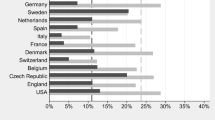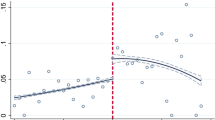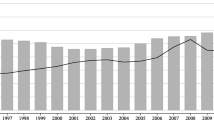Abstract
This paper provides an overview of the labour supply disincentive and the insurance effect of public disability insurance (DI) programmes targeted to permanently disabled adults. It builds on previous survey papers to review the empirical findings on the direction and magnitude of the DI effects on labour market participation. It particularly focuses on the consequences of altering specific parameters of the DI schemes, such as benefit amount, screening stringency and return-to-work incentives. Finally, it surveys the recent literature investigating the level of insurance against work-limiting health impairments provided by DI programmes and the value of DI for beneficiaries. This literature is of particular relevance in a period in which many countries are facing the challenge of reforming DI schemes to guarantee their sustainability.
Similar content being viewed by others
Notes
Estimates are classified according to the estimation strategy used, either times series or cross-sectional studies. The former are likely to be affected by other factors varying simultaneously with the policy change, the latter suffer from several issues regarding the identification strategy and the availability of prospective data.
They merged a number of administrative data sets. A 1% sample of all initial applications to DI from 1981 to 1999 is merged with the Social Security Administration’s (SSA) Master Beneficiary Record, which has information on the final benefit received, and with the SSA’s Master Earnings File, which has longitudinal information on earnings from 1978 to 2006.
Both SSDI and SSI are considered.
The Canadian DI system is similar to the US system, with the main differences being the lump-sum component of the benefit in Canada as opposed to a primarily earnings related benefit in the US and the stringency of the screening process which is higher in the US than in Canada.
I place the review of this literature in this section as the key policy change exploited by these contributions is a change in the payments’ generosity.
Autor and Duggan (2007) use data from the March Supplement to the Current Population Survey (CPS) for calendar years 2000 to 2006 for veteran males born between 1941 and 1952. Coile et al. (2015) use time-series data from the Current Population Survey for 1980 through 2014 and show that the LMP of veterans has declined with a pattern consistent with the increase in the Disability Compensation programme.
The administrative records cover 4% of the individuals who had contributed towards the social security system or had received contributory DI benefit during 2007.
The reintegration report summarizes the reintegration plan made by the employer and employee together, in which they specify an aim (resumption of current/other job under current/accommodated conditions) and the steps needed to reach that aim, and the outcome of the plan’s steps.
They use the entire panel, which covers a period of 48 years (1968–2015), and select male household heads aged 22 to 61 who were interviewed for at least six years.
References
Adam S, Bozio A, Emmerson C (2010) Reforming disability insurance in the UK: evaluation of the Pathways to Work Programme
Autor D, Ravndal Kostol A, Mogstad M, Setzler B (2017) Disability benefit, consumption insurance, and household labor supply, Working Paper 23466, National Bureau of Economic Research
Autor DH, Duggan M, Greenberg K, Lyle DS (2016) The impact of disability benefits on labor supply: evidence from the va’s disability compensation program. Am Econ J: Appl Econ 8:31–68
Autor DH, Duggan MG (2003) The rise in the disability rolls and the decline in unemployment. Quart J Econ 118:157–206
Autor DH, Duggan MG (2007) Distinguishing income from substitution effects in disability insurance. Am Econ Rev 97:119–124
Autor DH, Duggan MG, Lyle DS (2011) Battle scars? The puzzling decline in employment and rise in disability receipt among vietnam era veterans. Am Econ Rev 101:339–44
Autor DH, Maestas N, Mullen KJ, Strand A (2015) Does delay cause decay? the effect of administrative decision time on the labor force participation and earnings of disability applicants, Working Paper 20840, National Bureau of Economic Research
Ball S, Low H (2014) Do self-insurance and disability insurance prevent consumption loss on disability? Economics 81:468–490
Barr B, Clayton S, Whitehead M, Thielen K, Burström B, Nylén L, Dahl E (2010) To what extent have relaxed eligibility requirements and increased generosity of disability benefits acted as disincentives for employment? a systematic review of evidence from countries with well-developed welfare systems. J Epidemiol Commun Health 64:1106–1114
Benítez-Silva H, Buchinsky M, Rust J (2011) Induced entry effects of a \(\$1\) for \(\$2\) offset in SSDI benefits
Black D, Daniel K, Sanders S (2002) The impact of economic conditions on participation in disability programs: evidence from the coal boom and bust. Am Econ Rev 92:27–50
Borghans L, Gielen AC, Luttmer EFP (2014) Social support substitution and the earnings rebound: evidence from a regression discontinuity in disability insurance reform. Am Econ J: Econ Policy 6:34–70
Bound J (1989) The health and earnings of disability insurance applicants. Am Econ Rev 79:482–503
Bound J, Burkhauser RV (1999) Economic analysis of transfer programs targeted on people with disabilities. Handbook Labor Econ 3C:3417–3528
Bound J, Burkhauser RV, Nichols A (2003) Tracking the household income of ssdi and ssi applicants. In: Research in Labor Economics, Volume 22), (ed) orker Well-being and public policy. Emerald Group Publishing Limited, Polachek SW, pp 113–158
Bound J, Cullen JB, Nichols A, Schmidt L (2004) The welfare implications of increasing disability insurance benefit generosity. J Publ Econ 88:2487–2514
Bound J, Waidmann T (1992) Disability transfers, self-reported health, and the labor force attachment of older men: evidence from the historical record. Quart J Econ 107:1393–1419
Bütler M, Deuchert E, Lechner M, Staubli S, Thiemann P (2015) Financial work incentives for disability benefit recipients: lessons from a randomised field experiment. IZA J Labor Policy 4:18
Campolieti M (2004) Disability insurance benefits and labor supply: some additional evidence. J Labor Econ 22:863–889
Campolieti M, Riddell C (2012) Disability policy and the labor market: evidence from a natural experiment in Canada, 1998–2006. J Publ Econ 96:306–316
Chen S, van der Klaauw W (2008) The work disincentive effects of the disability insurance program in the 1990s. J Econom 142:757–784
Coile C, Duggan M, Guo A (2015) Veterans’ labor force participation: what role does the va’s disability compensation program play? Am Econ Rev 105:131–36
Dal Bianco C (2017) Health, disability insurance and labour supply. Evidence from a dynamic structural model, PhD thesis
de Jong P, Lindeboom M, van der Klaauw B (2011) Screening disability insurance applications. J Eur Econ Assoc 9:106–129
Deshpande M, Li, Y (2017) Who is screened out? application costs and the targeting of disability programs, Working Paper 23472, National Bureau of Economic Research
French E, Song J (2014) The effect of disability insurance receipt on labor supply. Am Econ J: Econ Policy 6:291–337
Garcia Mandico S, Garcia-Gomez P, Gielen AC, O’Donnell O (2018) Earnings responses to disability benefit cuts, Working paper 11410, IZA Institute of Labor Economics
Gelber A, Moore TJ, Strand A (2017) The effect of disability insurance payments on beneficiaries’ earnings. Am Econ J: Econ Policy 9:229–61
Gruber J (1996) Disability insurance benefits and labor supply, Working Paper 5866, National Bureau of Economic Research
Gruber J (2000) Disability insurance benefits and labor supply. J Polit Econ 108:1162–1183
Gruber J, Kubik JD (1997) Disability insurance rejection rates and the labor supply of older workers. J Publ Econ 64:1–23
Haveman RH, Wolfe BL (2000) The economics of disability and disability policy. Handbook Health Econ 1:995–1051
Karlström A, Palme M, Svensson I (2008) The employment effect of stricter rules for eligibility for DI: evidence from a natural experiment in Sweden. J Publ Econ 92:2071–2082
Kostl AR, Mogstad M (2015) Earnings, disposable income, and consumption of allowed and rejected disability insurance applicants. Am Econ Rev 105:137–41
Kostøl AR, Mogstad M (2014) How financial incentives induce disability insurance recipients to return to work. Am Econ Rev 104:624–655
Low H, Pistaferri L (2015) Disability insurance and the dynamics of the incentive insurance trade-off. Am Econ Rev 105:2986–3029
Maestas N, Mullen KJ, Strand A (2013) Does disability insurance receipt discourage work? Using examiner assignment to estimate causal effects of SSDI receipt. Am Econ Rev 103:1797–1829
Marie O, Vall Castello J (2012) Measuring the (income) effect of disability insurance generosity on labour market participation. J Publ Econ 96:198–210
Meyer BD, Mok WK (2018) Disability, earnings, income and consumption. Journal of Public Economics
Moore TJ (2015) The employment effects of terminating disability benefits. J Publ Econ 124:30–43
Mullen KJ, Staubli S (2016) Disability benefit generosity and labor force withdrawal. J Publ Econ 143:49–63
OECD (2010) Sickness. Breaking the Barriers, OECD Publishing, Disability and Work
Parsons DO (1991) The health and earnings of rejected disability insurance applicants: comment. Am Econ Rev 81:1419–1426
Ruh P, Staubli S (2018) Financial incentives and earnings of disability insurance recipients: Evidence from a notch design. Economic Policy, American Economic Journal
Staubli S (2011) The impact of stricter criteria for disability insurance on labor force participation, Journal of Public Economics, 95, 1223 – 1235, special Issue: The Role of Firms in Tax Systems
von Wachter T, Song J, Manchester J (2011) Trends in employment and earnings of allowed and rejected applicants to the Social Security Disability Insurance program. Am Econ Rev 101:3308–3329
Zaresani A (2017) Adjustment costs and incentives to work: Evidence from a disability insurance program, Unpublished
Author information
Authors and Affiliations
Corresponding author
Additional information
Publisher's Note
Springer Nature remains neutral with regard to jurisdictional claims in published maps and institutional affiliations.
Rights and permissions
About this article
Cite this article
Dal Bianco, C. Labour Supply and Welfare Effects of Disability Insurance: A Survey. Ital Econ J 5, 161–189 (2019). https://doi.org/10.1007/s40797-019-00086-z
Received:
Accepted:
Published:
Issue Date:
DOI: https://doi.org/10.1007/s40797-019-00086-z




